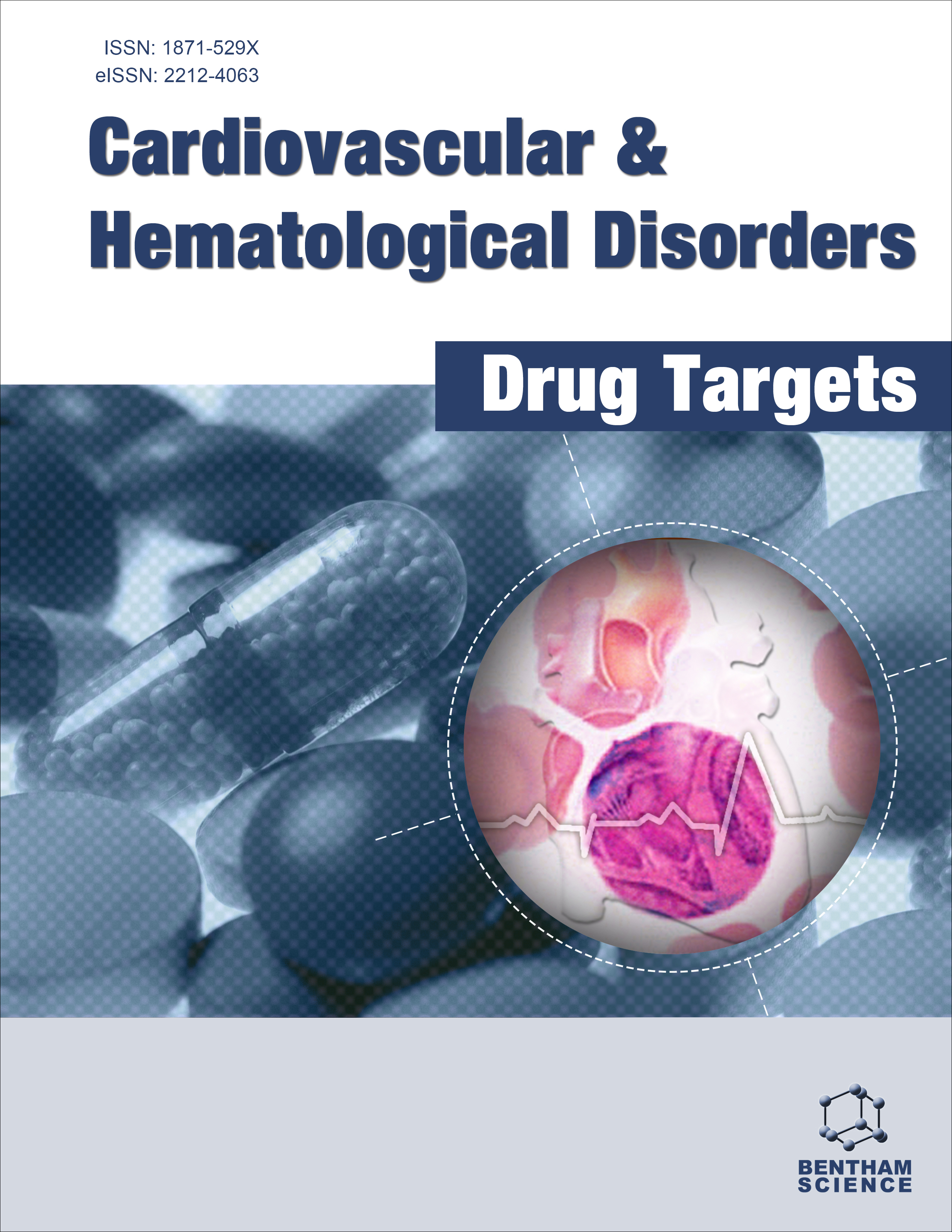- Home
- A-Z Publications
- Cardiovascular & Haematological Disorders - Drug Targets
- Previous Issues
- Volume 11, Issue 1, 2011
Cardiovascular & Haematological Disorders - Drug Targets - Volume 11, Issue 1, 2011
Volume 11, Issue 1, 2011
-
-
Editorial [Hot Topic: Ischemic Stroke in Very Old Patients (Guest Editor: Maria Cristina Zurru)]
More LessIn developed and developing countries, the population of very old people (more than 80 years) is expected to increase over the coming decades. By 2050, there will be an estimated 56.9 million nonagenarians worldwide, an 800% increase compared with today. In this group, the prevalence and incidence of stroke is very high, with great impact on morbidity and mortality. Only 10% of survivors may expect desirable recovery, Read More
-
-
-
Epidemiological Aspects of Stroke in Very Old Patients
More LessAuthors: Maria C. Zurru and Gabriela OrzuzaIn developed and developing countries, the population of very old people (more than 80 years) is expected to increase over the coming decades. By 2050, there will be an estimated 56.9 million nonagenarians worldwide, an 800% increase compared with today. In this group, the prevalence and incidence of stroke is very high, with great impact on morbidity and mortality. Only 10% of survivors may expect desirable recovery, Read More
-
-
-
Acute Management in Very Old Patients: Is Thrombolysis Safe?
More LessAuthors: Maria C. Zurru and Fabiana OrtegaIn our analysis, patients who were treated with intravenous rt-PA had a better outcome than untreated patients, and this effect was not dependent on age. The weight of evidence to date indicates a potential for benefit in older people, and there is no a priori reason to suspect a diminished effect when compared with younger people. The risk of bleeding is similar in both groups. We believe that clinical treatment guidelines s Read More
-
-
-
Is It Possible to Apply Secondary Stroke Prevention Guidelines to Very Old Populations?
More LessThe aging population is an undeniable reality which must be faced by all health systems all over the world. Among people over 80 years old, increase in stroke incidence, high mortality rates and adverse outcomes are problems of major public concern. Lack of evidence-based data to guide rational decision making on vascular risk factors management to avoid recurrence in elderly stroke patients increases the areas o Read More
-
-
-
Myths and Facts Concerning the Use of Statins in Very Old Patients
More LessAs population grows old, the number of persons at risk of cardiovascular events also grows. Though octogenarians form a small percentage of the general population their absolute risk of coronary and cerebrovascular disease is high, but there is still some doubt as to whether high plasma cholesterol levels increase vascular risk in this age group, as published data are conflicting. There is evidence that elevated plasma chol Read More
-
-
-
Anticoagulant Therapy in Very Old Patients
More LessOlder patients are less likely than younger patients to receive anticoagulation and are more likely to be underanticoagulated. Although the use of warfarin in the elderly has been increasing, fewer than half of eligible patients take warfarin. Evidence suggests that stroke recurrence in patients on oral anticoagulation is mainly ischemic, and hemorrhagic complications that derive from oral anticoagulation would be related to ove Read More
-
-
-
Pathogenesis of Neointima Formation Following Vascular Injury
More LessAuthors: Ali Pourdjabbar, Benjamin Hibbert, Trevor Simard, Xiaoli Ma and Edward R. O' BrienRevascularization remains the cornerstone of managing obstructive coronary artery disease. Although percutaneous coronary interventions involving the insertion of metal scaffolds, known as stents, has emerged as the preferred method of restoring vessel patency, as many as 30% of patients will experience a gradual re-narrowing of the lumen caused by neointima (NI) formation, resulting in a condition known as in-st Read More
-
-
-
Pathogens and Chronic or Long-Term Neurologic Disorders
More LessAuthors: Ioannis Starakis, George Panos, Angelos Koutras and Elias E. MazokopakisInfections of the central nervous system may provoke glial and autoimmune responses but a definitive linkage between these infections and the pathogenesis of chronic neurologic disorders is still elusive. There are controversial reports implicating infectious agents in the pathogenetic mechanisms of chronic or long-term neurologic disorders, such as multiple sclerosis, amyotrophic lateral sclerosis, Parkinson's disease, Read More
-
-
-
Effect of Simvastatin use on Autonomic Function in Patients with End Stage Renal Disease
More LessAuthors: Bhupinder Singh, Balaji Srinivasan and Sriram S. NarsipurBackground: Heart Rate Variability (HRV) is a reliable measure of autonomic function. It is positively influenced by treatment with an HMG-CoA reductase inhibitor (statin) with resultant improvement in parasympathetic tone in the general hyperlipidemic population. We tested the hypothesis that autonomic function would improve following 4 weeks of treatment with a statin by conducting a randomized, double-blind, placebo- Read More
-
Volumes & issues
-
Volume 24 (2024)
-
Volume 23 (2023)
-
Volume 22 (2022)
-
Volume 21 (2021)
-
Volume 20 (2020)
-
Volume 19 (2019)
-
Volume 18 (2018)
-
Volume 17 (2017)
-
Volume 16 (2016)
-
Volume 15 (2015)
-
Volume 14 (2014)
-
Volume 13 (2013)
-
Volume 12 (2012)
-
Volume 11 (2011)
-
Volume 10 (2010)
-
Volume 9 (2009)
-
Volume 8 (2008)
-
Volume 7 (2007)
-
Volume 6 (2006)
Most Read This Month
Article
content/journals/chddt
Journal
10
5
false
en


